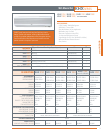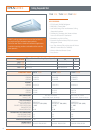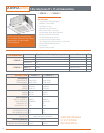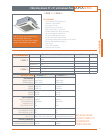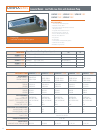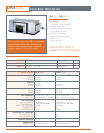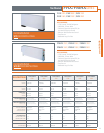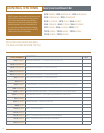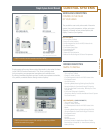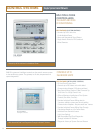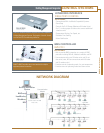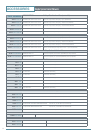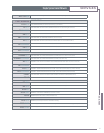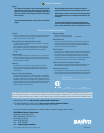
Usage
○
The air conditioners listed herein are only for cooling/heating areas used by
people. Do not use the unit for foods, animals, plants, precision machines,
works of art or other objects. Doing so may cause damage to the unit. Do not
use the unit for vehicles or vessels. Doing so may cause unit water leakage
and short circuiting.
○
Please read the Operating Instructions carefully and use the air conditioner
properly.
○
Requires a qualified technician/installer to install the air conditioner.
Improper self-installation may result in water leakage, electric shock or fire.
○
When installing in a small room, take measures to keep refrigerant leakage
within acceptable density limits, as outlined by local/national safety code
requirements.
○
Do not install where inflammable gas may leak or inflammable objects
exist. Do not install where there is any inflammable gas emission, inflow or
leftover, or where carbon fibers are in the air. This could be the cause of fire.
Location
Blocking air intake or outlet can be the cause of trouble including the
loss of air flow power, or short-cycled air emission drawn into the
intake. Be sure to install in an airy place.
Avoid Installation in Highly Humid Locations
(1) Avoid installation where the humidity is excessive. This causes
condensation during cooling.
(2) Installation in a room where the temperature and humidity are
high around the ceiling due to sunlight will result in condensation.
Use insulation or take other preventive measures to block the
sunlight.
Exposure to Oil
Avoid installation where there is exposure to oil or soot (such as in
kitchens or machinery plants). Oil will adhere to the heat exchange.
This will lower heat exchange performance, emit mist, or deform or
damage synthetic resin parts.
Cleaning
After using the air conditioner for several seasons, the insides
become dirty and this results in low performance. In addition to
regular cleaning, a maintenance contract with a service person is
recommended.
Features of Heat Pump Heating
Heating power (kW) indicated in the catalog is based on the following
conditions: outdoor temperature of 47°F (DB) and indoor temperature of
70°F (DB), as specified by ARI. Heating capacity decreases as outdoor
temperature drops. Therefore, if heating power is insufficient due to low
outdoor temperature, use the air conditioner together with other heating
equipment. When heated air rises and collects in a room with a high
ceiling, install an air circulator as well.
Operation Range
Outdoor Air Intake Temperature:
Cooling: 14 ~ 109°F (DB) Heating: - 4 ~ 59°F (WB)
Noise Emissions
The noise emission rate indicated in the catalog shows values (A
scale) measured in an anechoic chamber. In actual installation
conditions, noise emission is generally greater than the indicated
rate due to surrounding noise and echoing.
Odor Emissions
Even though an air conditioner does not contain odor-emitting parts,
discharged air can, in certain conditions, have an unpleasant odor.
This is the result of odorous particles such as ones from smoke,
cosmetics, and foods, affixing themselves to the air conditioner.
Although the odor does not affect the performance, cleaning the air
filter and the inside of the air conditioner is recommended.
Noise Caused by Electromagnetic Waves
When installing near equipment that emits electromagnetic waves,
be sure that the air conditioner does not suffer noise damage.
Remote Control Wiring
For remote control wiring and control wiring between indoor units,
do not install with the power wiring (208/230V) in the same tube nor
wherever power wiring exists. Doing so may cause a malfunction
Do not install an air conditioner in a room where the limit density will be exceeded if refrigerant leaks. The refrigerant (R410A) used by this system is it-
self a safe refrigerant; however, if for some reason the refrigerant leaks and the limit density is exceeded, there is a risk of injury to persons due to a lack
of oxygen. For further information, ask your dealer or consult references such as an engineering manual to ensure you install the air conditioner correctly.
For further information and training or to request additional product catalogs, please contact:
SANYO North America Corporation
Commercial Solutions Division
1690 Roberts Blvd., NW Suite 110
Kennesaw, GA 30144
Phone: (678) 355-6635
Fax: (678) 355-6684
Web: http://us.sanyo.com/hvac
©2011 SANYO North America Corporation. All rights reserved. CSDHVACECO0111
Dealer Network Courses: http://us.sanyo.com/hvac/Dealer-Certification
ECOi Web Based Dealer Training Video: http://us.sanyo.com/hvac/On-Demand-Videos
• Includes ECOi Installation & Commissioning procedures and much more.
ISO Certification
SANYO Electric Air Conditioning Co., Ltd. (Tochigi Japan)
ISO 9001 ISO 14001
Certificate Number: JQ116B Certificate Number: EC00J0303-33
Caution On Installation and Use
Safety Precautions



